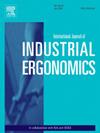The impact of camera-monitor system viewing angles on drivers’ distance perception: A simulated driving study
IF 3
2区 工程技术
Q2 ENGINEERING, INDUSTRIAL
International Journal of Industrial Ergonomics
Pub Date : 2024-10-19
DOI:10.1016/j.ergon.2024.103657
引用次数: 0
Abstract
Camera-monitor systems (CMS) are increasingly used in driving. CMS separates the driver's sight line from the camera view, due to the lack of mirror reflection, only changing the camera's visual axis angle may affect the driver's rear view perception. While previous research has explored camera height and field of view, the effects of horizontal and vertical viewing angles alone remain unclear. This study aimed to evaluate how the horizontal viewing angle and vertical viewing angle of CMS camera affect distance estimation and car-following tasks. By changing the horizontal and vertical viewing angle, different self-vehicle references and horizon positions were formed in the image. Two experiments were conducted with the CMS around the steering wheel (Experiment 1) and at the bottom of the A-pillar (Experiment 2). Independent variables were the horizontal viewing angle (reference scale: 1/4, 1/3, 1/2) and vertical viewing angle (horizon position: 1/2, 1/3). Dependent variables included distance estimation error ratio and following distance. Experiment 1 demonstrated a significant interaction effect: a smaller reference scale and higher horizon position reduced distance underestimation. Additionally, a smaller reference scale for the participants' self-vehicle resulted in shorter following distances. In Experiment 2, the distance estimation outcomes on the left display aligned with those of Experiment 1; however, the influence of the viewing angle was diminished on the right display. The study suggests CMS design should balance vehicle reference inclusion with environmental cues, enhancing distance perception and driving safety. The consistency between CMS design and driver familiarity also needs to be considered.
摄像监控系统视角对驾驶员距离感的影响:模拟驾驶研究
摄像头监控系统(CMS)在驾驶中的应用越来越广泛。CMS 将驾驶员的视线与摄像头的视线分开,由于没有镜面反射,只有改变摄像头的视轴角度才可能影响驾驶员的后视感知。虽然之前的研究已经探讨了摄像头的高度和视野,但仅凭水平和垂直视角的影响仍不明确。本研究旨在评估 CMS 摄像机的水平视角和垂直视角如何影响距离估计和汽车跟随任务。通过改变水平和垂直视角,在图像中形成不同的自车参照物和地平线位置。我们进行了两项实验,分别将 CMS 安装在方向盘周围(实验 1)和 A 柱底部(实验 2)。自变量为水平视角(参考比例:1/4、1/3、1/2)和垂直视角(水平位置:1/2、1/3)。因变量包括距离估计误差比和跟车距离。实验 1 显示了显著的交互效应:较小的参考比例和较高的水平位置会减少距离低估。此外,参与者自驾车的参考尺度越小,跟车距离越短。在实验 2 中,左侧显示屏的距离估计结果与实验 1 一致;但在右侧显示屏上,视角的影响减弱了。研究表明,CMS 的设计应平衡车辆参照物与环境线索之间的关系,从而提高距离感知能力和驾驶安全性。此外,还需要考虑 CMS 设计与驾驶员熟悉程度之间的一致性。
本文章由计算机程序翻译,如有差异,请以英文原文为准。
求助全文
约1分钟内获得全文
求助全文
来源期刊
CiteScore
6.40
自引率
12.90%
发文量
110
审稿时长
56 days
期刊介绍:
The journal publishes original contributions that add to our understanding of the role of humans in today systems and the interactions thereof with various system components. The journal typically covers the following areas: industrial and occupational ergonomics, design of systems, tools and equipment, human performance measurement and modeling, human productivity, humans in technologically complex systems, and safety. The focus of the articles includes basic theoretical advances, applications, case studies, new methodologies and procedures; and empirical studies.

 求助内容:
求助内容: 应助结果提醒方式:
应助结果提醒方式:


